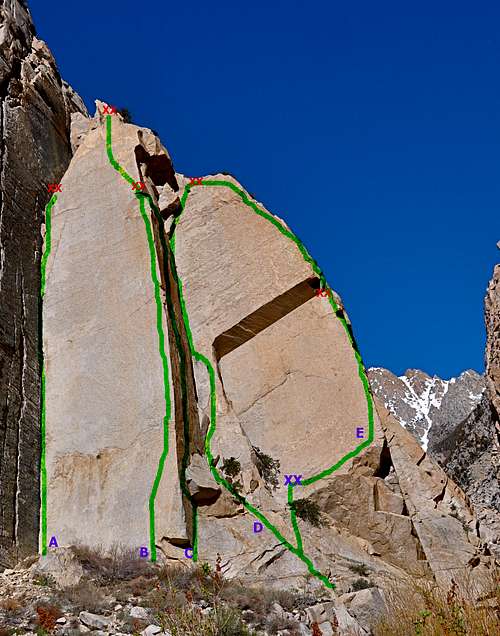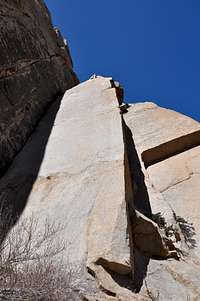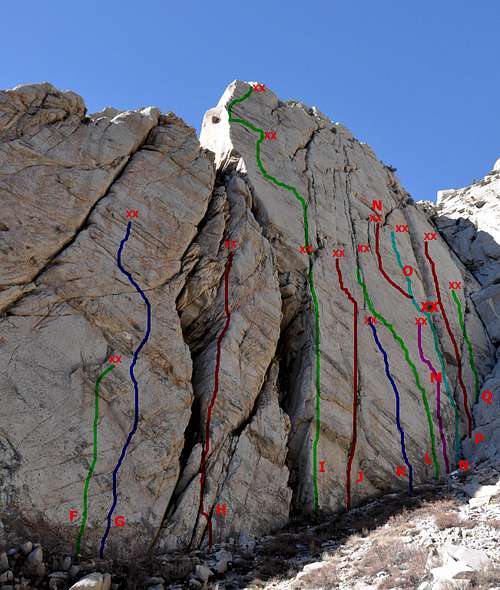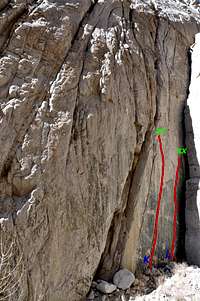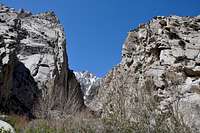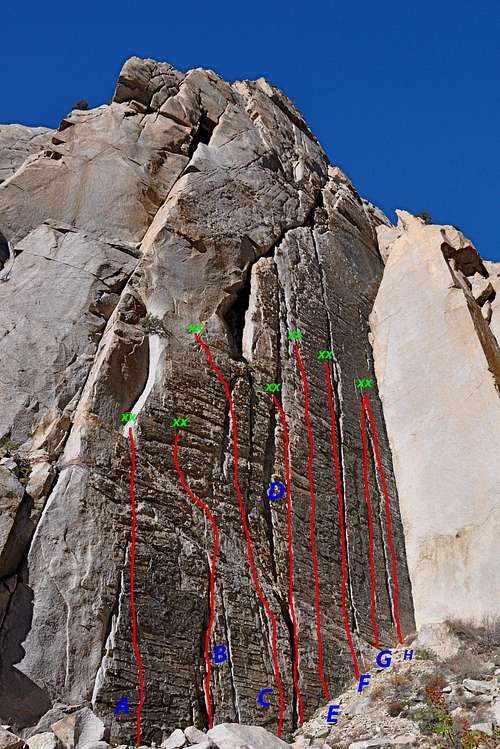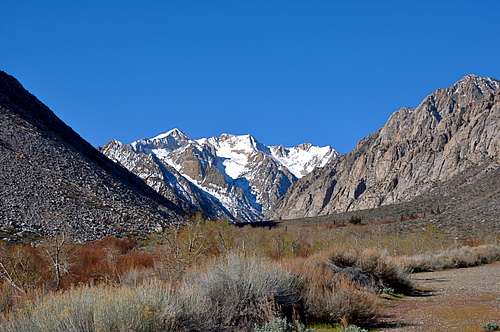-
 13461 Hits
13461 Hits
-
 94.82% Score
94.82% Score
-
 49 Votes
49 Votes
|
|
Area/Range |
|---|---|
|
|
37.38338°N / 118.67674°W |
|
|
Trad Climbing, Sport Climbing |
|
|
Spring, Summer, Fall |
|
|
7000 ft / 2134 m |
|
|
Overview

Pratt’s Crack area consists of a series of adjoining rock formations inside a narrow slot canyon, one of the subsidiaries of Pine Creek Canyon of the Eastern Sierras.
The road to Pine Creek Canyon takes you past beautiful green pastures and majestic views of Mount Tom and Wheeler Crest. The road to the town of Rovana, on the way to Pine Creek Canyon, is lined with tall trees and huge green fields. If you are lucky, you will get to see wildlife roaming around and relaxing under the blue Sierra skies.
Passing through the town of Rovana, the mouth of Pine Creek Canyon begins to open to welcome you into its breathtaking alpine suroundings. The road winds up a twisting two-lane road lined by pine and willow trees. After a few miles you begin to see granite formations up the hillsides and you wonder about possible routes. The most impressive rocks are near the end of the road and to your right. You will notice narrow gullies connected by granite buttresses and faces.
Across from a primitive campground, you will notice a very narrow gully flanked by steep walls on both sides. Peer into this narrow slot canyon that is so close to the road that you want to reach out and touch it. You see a dihedral with a smooth face and a crack. You can see the crack from here because it’s wide. It’s very wide. This is Pratt’s Crack, an off-width that sends shivers down sport climbers’ spines. It was the first climb done in this area by the legendary Yosemite big wall climber, Chuck Pratt. It is important to know that this climb was done in 1968, long before the invention of camming devices; never mind the six inch and up ones that you see in the market today. This crack became the quintessential off-width in the eastern Sierras and later the entire area was named after it.
As the Pratt’s Crack area became more and more popular, a number of classic lines were established on the neigboring formations. Rites of Spring, a beautiful four pitch climb was established in the late 1970s and became the prize of the area. In the early 1980s, when sport climbing was making its full impact on the sport of rock climbing, another line went up a seemingly featureless arete to the right of Pratt’s Crack. This was Ecstasy, rated 13a, estblished by Tom Herbert, the son of another Yosemite big wall pioneer, T.M. Herbert. At the present time, most of the formations in this gully are east facing and divided into separate areas. This “Area” page will cover Dihedrals, Rites Buttress, Mustache Wall, Gecko Wall, Ministry Wall, The Slabs, and Cyanide Cliff.
There are other formations inside and outside of this canyon that are not covered in this page. My hope is that other Summit Post members or I will make additional submissions in the future to supplement this page.
Being at an elevation of seven thousand feet and in the shade for a good part of the day, several of the formations here are great for warm weather climbing. There is a running creek fed by snow-melt from Scheelite Chute starting some six thousand feet above the canyon. Enjoy the drive, enjoy the mountain scenery and have a safe climbing adventure.
Dihedrals
DihedralsDihedrals were what drew you into this canyon to begin with. This is a beautiful formation physically connected to (Ministry Wall) on the left by the means of Pratt’s Crack, and Gecko Wall on the right. Dihedrals embody some of the best trad climbing as well as sport routes that this area has to offer. It has a moderate crack that requires gear placement for protection. It’s called “Sheila” rated at 10a, and it’s a must do.
Dihedrals also offer a bolted climb called “Ecstasy, 13a” that evokes awe and admiration. The smooth and steep arete that you saw from the road was first climbed by Tom Herbert, the son of the famous Yosemite climber T.M. Herbert. He named the climb Ecstasy.
And then there is Pratt’s Crack. Pratt’s Crack was the first climb that was established in this canyon by another Yosemite original, Chuck Pratt. Many people refer to the entire canyon as “Pratt’s Crack” area. This very wide crack, rated at 5.9, will test your physical and mental abilities. Don’t let the moderate rating fool you. Keeping a cool head knowing that the crack can spit you right off at any time is not an easy thing to do. You can take a truck load of protection, but after you place each piece you have to climb past that piece. Climbing off-width cracks require skills that don’t come easily. More...
| A | Pratt's Crack, 5.9, gear |
| B | Ecstasy, {pitch 1, 13a} {pitch 2, 12c} bolts |
| C | Cracker, C3+ |
| D | Sheila, 10a, gear |
| E | Eclipsed, {pitch 1, 11d} {pitch 2, 10c} |
Rites Buttress
Rites ButtressRites Buttress is physically connected to Ministry Wall and is an important multi pitch buttress in the Pratt’s Crack area of Pine Creek Canyon.
All the praising words that have been written about climbing in this area-and even more-apply to Rites Buttress. Rites Buttress is unique because of its traditional roots. Unlike on Ministry Wall, next door, that was developed as a sport climbing area, you need to depend on your own skills and experience to protect your climbs. You need to be a crack climber and a face climber to complete any of the routes here. In other words, you need to be an all around climber to climb on the Rites Buttress.
There is a saying, “The greater the effort, the greater the rewards.” That saying definitely holds true for The Rites Buttress. When you climb on this buttress you are treated to the best of what this beautiful formation has to offer at the end of every pitch. If you have only sport climbed, you know very well that you hardly ever turn around and look at what’s behind you. In contrast, when you are trad climbing, you cannot help but to look at the exposure and the views while belaying.
If you are a sport climber, you may walk past Rites Buttress and not even notice the beautiful crack systems that stretch toward the sky. Actually, these cracks were noticed and climbed as far back as the 70’s. At that time bolted sport climbs were nowhere to be found; in fact, sport climbing had not yet been invented. It seems to me that the basics of sport climbing were invented by trad climbers trying to free climb bolt ladders. Bolt ladders were used to climb past the seemingly blank sections of rock to get from one crack/chimney system to another. As climbers got better at their craft, they wanted to free climb faces and thin cracks that were traditionally aid routes. It took the next genetration of climbers to develop this practice into a whole new sport. More...
Mustache Wall
Mustache WallThe history of climbing on Mustache Wall dates back to 1985 when Allan Bartlett established “Octoberfest, 10b” on the far left hand side. True to his principles, Allan used gear to do the first ascent of this climb. Needless to mention, sport climbing had already made its full impact on the sport of rock climbing at that time. However, the full potential of Mustache Wall was recognized and explored starting in 2004 when many sport routes were established on the entire virgin face. Even one of the routes on the left hand wall that climbs next to a crack has been bolted. The mindset behind bolting next to a crack could be that once someone does that in an area, then this practice becomes an accepted method and common place by the subsequent first ascenters. In the late 1990’s I noticed the first signs of bolts next to cracks on Ministry Wall a few walking minutes from Mustache Wall.
The difficulty level on Mustache Wall seems to run a fairly wide gammit. Except for a few 5.10s and 5.12s, the rest of the routes are in the 5.11 range. Thanks to the climbers and all the hard work that they put into safely bolting and creating great anchors on all the routes here, you are treated to one of the best sport climbing formations I have seen in the Eastern Sierras.
For those few climbers still not satisfied by Mustache Wall and looking for more 5.12s, they can always visit Gecko Wall or Ministry Wall only a short walk up the canyon from here. More...
Climbs of Mustache Wall, left side |
|
| A | B-Gizzle, 10c, 7 bolts |
| B | Flame Thrower, 11d, 13 bolts |
| C | Dakota Street Bypass, 12a, 11bolts |
| D | Phenomena, 11b, 11 bolts |
| E | Climbs of Mustache Wall, middle and right sides |
| F | The Notorious B.E.G. 11c, 6 bolts |
| G | Coven, 11b, 12 bolts |
| H | Becky Route, 10a, 13 bolts |
| I | The Megaplex, 11c, 3 pitches, many bolts |
| J | Double Dog Dare, 11c, 13 bolts |
| K | Aromatic, 12d, 11 bolts |
| L | Stone Cold Fusion, 12a, 16 bolts |
| M | Window Shopper, 11c, 12 bolts |
| N | Super Grinder, 10d, 2 pitches, bolts |
| O | Sidecar, 10c, a gear climb, do the 1st pitch of Super Grinder, then jump on Sidecar |
| P | Mr. Ridiculous, 11a, 15 bolts |
| Q | Gala Jumble, 10d, 13 bolts |
Note: There are two more routes to the left of B-Gizzle that are not included in the photo or the table of the climbs.
Gecko Wall
Gecko WallIn contrast to Dihedrals, Gecko Wall is not the best looking rock you have climbed in your life. Gecko Wall, however, offers many difficult sport routes, all in the 5.12 range. What the ratings indicate is that it helps to be, at least in part, a gecko to have much hope to complete any of the pitches here.
Gecko Wall is completely hidden behind “Dihedrals” that juts out into the canyon. Being entirely north facing, Gecko Wall stays in the shade all day thus making it a desirable formation to climb during the warmer seasons. Added to that, it’s situated right next to a running creek that gives you the relief that you need in between burns.
By the end of Gecko Wall the most accessible climbing in this canyon ends. There are many route possiblilties beyond Gecko Wall; however, the next established area, as of 2009, is a grueling hike up a steep scree and boulder field that discourages most sport climbers. I have no doubt this area will be developed in the future as well. The obscure trail that winds its way up this steep section is in bad need of improvement, and that will come in time as well. Mike Strassman, the person responsible for this trail, will smile down upon us all from heaven. More...
| F | Wind In The Willows, {pitch 1, 11d, 9 bolts} {pitch 2, 12d, clip the anchor and continue past 5 more bolts to second anchor} |
| G | Planetarium, 12a, 7 bolts to anchor |
| H | Rage, 12c, 7 bolts to anchor |
| I | Atomic Gecko, 12b, 7 bolts to anchor |
| J | Biohazard, 12a, 6 bolts to anchor |
| K | Chronic, 12a, 6 bolts to anchor |
| L | Bubonic, 12c, 5 bolts to anchor |
Ministry Wall
Ministry Wall| Climbs of Ministry Wall | |
| A | Twitch, 12a, 6 bolts |
| B | Effigy, 11b, 8 bolts |
| C | Burning Inside, 11c, 10 bolts |
| D | Stigma, 11a, 6 bolts |
| E | Neighborhood Watch, 12a, 8 bolts |
| F | Never Believe, 10c, 8 bolts |
| G | New World Order, 11d, 7 bolts |
| H | Deity, 11c, 7 bolts |
Looking at the list of Climbs on Ministry Wall and the ratings gives you a clue as to the level of climbing you need to be ready for to climb here. Except for one 10c climb, the rest of the routes on this formation are in the 5.11, and one 5.12, range. In short, you’d better be ready to pull on some very small fingernail holds on steep rock. The only 10c climb here is called “Never Believe” which is a flaring crack. If you enjoy climbing flaring cracks, there is another one just to the right of Never Believe and it’s called Diety, rated at 11c protected by seven bolts ending on a double cold shuts anchor. In the old times we would have shuttered at the thought of any bolts next to a crack, let alone an anchor at the end of every pitch. Today, however, this practice is not even an issue. Good, climbing here is all safer and saner now. More...
The Slabs
The SlabsThe history of climbing on The Slabs dates back to the early part of the 1970s when Helmut Keine, an exchange student who was a talented climber, established Keine Route, 10a.” I have no doubt doing first ascents, in the 5.10 difficulty level, in the old climbing shoes with stiff lug-soles of the early 1970s was quite an experience. In the following decades, however, other talented American climbers such as Allan Bartlett and Tony Puppo made their mark by establishing a number of climbs over the entire face. Two of such climbs are Ill Wind, 5.9 and Newlywed Game, 10b.
We all owe these early pioneers a debt of gratitude for their vision and tenacious pursuit of new lines on virgin rock formations.
Besides Dihedrals, The Slabs is the only formation in The Pratt's Crack area that is south facing and in the sun for most of the day. This would be a great place to climb soon after a freaky summer or fall season storm. Even though this area is at an elevation of over seven thousand feet, climbing on the south facing slabs in the summer season may not be what most people would be looking forward to. But, when the weather begins to cool down for the overnight frost to cover everything, The Slabs will warm up nicely for a day of climbing. More...
The Slabs, Pine Creek Canyon | |
| 1 | Ill Wind, 5.9, two pitches, Standard Rack, pro, up to 3 inches |
| 2 | Instant Insanity, 10c, Standard Rack |
| 3 | Newlywed Game, 10b, Two pitches, standard rack |
| 4 | Topless Dancer, 10a A0, Two pitches, standard rack |
| 5 | Keine Route, 10a, two pitches, Standard rack, gear up to 4 inches |
| 6 | Inyo Face, 10d, bolts |
| 7 | Bwana Dik, 10d, three pitches, Standard Rack, pro up to 3 inches |
Cyanide Cliff
Cyanide CliffAt the elevation of 7000 feet, Cyanide Cliff is located just outside of the steep and narrow gorge where most of the climbing activity takes place. The major formations inside the gorge include Ministry Wall, Rites Buttress and Mustache Wall. These walls are all steep and climbing on them of a higher degree of difficulty. Cyanide Cliff, on the other hand, is generally lower angle and includes a few more moderate routes. The easiest route on this cliff is called Mystery Novel" and is rated 5.3 which is very unique to the area. The best route for the intermediate climber is also one of the best on this cliff. This route is called "Triple Jeopardy" and is rated 5.9. Most of the routes are rather long. Bring two ropes to rappel.
Being situated part way up a steep hill clearly visible from the climbers parking lot, Cyanide Cliff often goes without much attention. Most climbers visiting this area head for the formations located inside of the gorge. This cliff, however, has much more to offer than it gets credit for. Cyanide Cliff is south facing and gets the warm rays of sun all day long for those early-season visitors to this area. This cliff is also the first formation to lose its snow after a snowfall. More...
Select routes of Cyanide Cliff | |
| A | My Dirty Secret, 10c, bolts, Standard Rack, pro to 3.5" |
| B | My Novel, 5.3, Standard Rack |
| C | Triple Jeopardy, 5.9, Standard Rack |
How to get there
From the town of Bishop, California, drive about ten miles north on highway 395 to its intersection with Pine Creek Road & Rovana. Take this exit and continue west on Pine Creek Road past the town of Rovana for about 7.6 miles. You will see many rock formations to your right and a canyon that is very narrow and steep. Drive a bit further till you come to a dirt road. Turn right on this road, then take another sharp turn to the right. This short and rough dirt road will quickly take you to the climbers’ parking area. The trail into the canyon is obvious and shouldn’t take more than ten minutes.The views you are treated to on your drive up Pine Creek Road are breathtaking. Take a few minutes for a few photos. You will be happy to have them in twenty years.
Camping
There is one primitive campground with a few campsites across from the slot canyon. However, there are many more developed campgrounds in the vicinity of Bishop to the south and in the Rock Creek Canyon further north of here.
The following links should help finding a good campsite:
Horton Creek Campground
Rock Creek Canyon
Inyo National Forest
Bishop Creek and vicinity camping












